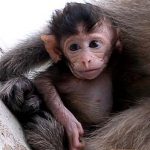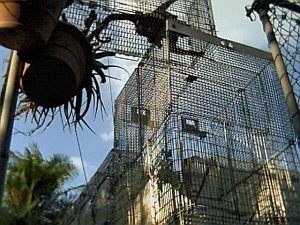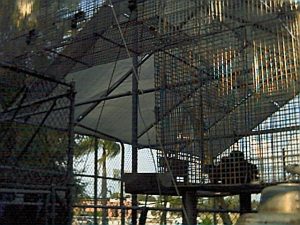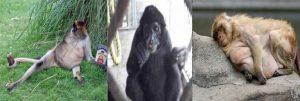Does My Monkey Seems A Bit Chubby?
Obesity In Pet & Captive Monkeys
Fat Monkeys Why It Happens – What You Need To Do About It
Ron Hines DVM PhD
 Click the ark to see what vaccinations monkeys might require
Click the ark to see what vaccinations monkeys might require
 Dealing with diabetes in monkeys here
Dealing with diabetes in monkeys here
Obesity is the biggest problem I see in pet and captive monkeys. Even wild monkeys, fed by tourists, have this problem. In the United States, people often keep monkeys as child substitutes and buddies – and who can “starve” their own family member? The problem is that being overweight brings the same health hazards to monkeys that it does to human beings. The most common of these health hazards is diabetes – but heart disease, cancer, and a faster advance into old age are others.
What Are Some Of The Things That Cause Monkeys To Get Fat?
The most common reasons monkeys get fat are:
![]() Foods too plentiful and rich in calories = Sweets, Starches And Fats
Foods too plentiful and rich in calories = Sweets, Starches And Fats
![]() Not enough fiber in the monkey’s diet
Not enough fiber in the monkey’s diet
![]() Natural monkey food greed
Natural monkey food greed
![]() Monkeys kept as solitary pets
Monkeys kept as solitary pets
![]() Inactivity and a sedentary lifestyle
Inactivity and a sedentary lifestyle
![]() Too small an enclosure for adequate exercise
Too small an enclosure for adequate exercise
![]() Boredom
Boredom
Too Many Sweets, Starches And Fats
Monkeys are perpetual children in their taste preferences. Given their choice, they will always go for the sweetest, starchiest and fattiest foods available. And they will instinctively eat them greedily and quickly so the rest of their imaginary troop doesn’t eat them first. Eating any of these foods in quantity is a path directly to the doorstep of diabetes.
Too Much Food Availability
We know that monkeys, given the chance, will eat too much for their own good. We know that in rhesus monkeys, eating 30 % less calories over their lifetime considerably reduces their incidence of Type II diabetes, and greatly increases how healthy they will be and how long they will live. Most pet monkeys are very small in relation to people. It is very easy for you to monkey owners to over-estimate the food needs of their pet monkeys.
Monkeys are greedy eaters. There may be two reasons for this. The first is that they naturally live in group and are pre-programmed to eat as much as possible before other monkeys in the group can get it. The second is that at least some monkeys apparently share the same genetic characteristics of some humans to accumulate fat reserves during times of food plenty order to survive times when food is scarce (metabolic syndrome )
Not Enough Fiber And Other Roughage In Their Diets – Jungle Food vs Supermarket Food
The natural diets of monkeys in the wild is not the same as the diets we usually feed pet monkeys. Even store-bought fresh produce, fruit and many vegetables have considerably less fiber and protein that the foods monkeys normally eat in the wild and the sugars in them differ. ( ref )
Hand-raised By Humans On Human Food
Monkeys establish their dietary preferences early in life. Most commercial monkey breeders remove the babies when they are very young and hand-raise them. They often feed these monkeys high fat, high sugar items that influence the monkey’s later habits. Monkey owners have no problem feeding these items to their breeder animals because the breeders lead a much more active lifestyle in larger outdoor cages and experience the added nutritional needs of repeated pregnancies.
Mother monkeys housed in stressful situations (small cages, incompatible side-by-side groups, etc.) can also have hormone surges that lead to abnormal fat metabolism in their babies – a risk factor for later diabetes. (ref)
Monkeys Kept As Bored, Solitary Pets
Monkeys are highly social animals. When they are alone and bored, they resort to food consumption to pass the time.
Inactivity And A Sedentary Lifestyle
In the wild, food does not come easy. In the movies, the jungle is full of fruit, nuts and berries. But it really isn�t that way. Monkeys must climb and travel long distances throughout the day to find enough to eat. In doing so, they burn a lot of calories and get the exercise they need to keep their bodies healthy. That just doesn’t occur in cages, and home environments where food arrives in a bowel every morning. God did not design monkeys to live a lazy life style in a human family or in the zoo. In the wild, monkeys in a group are constantly interacting, chasing each other and vying for their place in the peck order. The Alpha individuals regulate the food intake of all the subservient monkeys in the troop and, themselves, burn more calories doing so and guarding the group from danger.
Too Small An Enclosure
Many pet monkeys are kept in enclosures that are entirely too small. Monkeys need to move about, jump, climb and play to keep their bodies healthy. Most private owners just do not have enough space to build zoo-size enclosures and islands. What I have found helpful is constructing long hanging skyway chases runs and tubes at different heights leading to smaller enclosures. 


Plenty of heavy maritime ropes, resting ledges and environmental enrichment are also very important.
What Should I feed My Monkey?
I can not give you specific daily monkey menus because there are so many sizes and types of monkeys. Monkeys also have different requirements depending on their age, activity level and environment.
Here is what you need to do:
Look up the normal body weight for your type of monkey At the University of Wisconsin primate website or another that gives the normal weight of monkeys. That will tell you what your monkey needs to weigh to remain healthy. Most monkeys will do well when fed 2-3% of their normal body weight per day. Every monkey has somewhat different nutritional needs. So there are no hard rules. You need to weigh the monkey frequently to see that your diet plan is keeping the monkey at its normal, wild, mature body weight.
Commercial Monkey Biscuits
You can feed monkeys individual foods that will meet all its needs. But it is easier and safer to rely on the experience of trained veterinary nutritionist. There was a time when commercial feed mills produced chows that were too rich in calories and fats and too low in fiber. That is no longer the case. I suggest that monkey biscuits make up 30 – 40% of your monkey’s food intake and that you supply the rest in fresh produce. (Mazuri formulated these diets to be fed as “about half” the monkey’s diet)
There are many companies producing monkey biscuits. I have used those produced by Purina Mills for my whole career – so I will suggest those. Purina Mills has a large dedicated staff of animal nutritionists. The chows I suggest you use are the high-fiber, reduced calorie ones sold by either their Mazuri or PMI (Purina) branches. Mazuri concentrates on zoo and display monkey products while PMI primarily supplies institutions housing research monkeys. PMI/Mazuri’s 5MA4, 5052, 5LG1 and 5LK7 and 5M02 are all good diets to consider for weight reduction plans. Discuss your particular monkey species with them before you decide on a specific product and please read through the technical monkey nutritional articles they provide (primate technical papers).
Fresh Produce
When you feed fresh produce, feed variety. Try not to let your monkey become fixated on single ingredients � particularly sweet ones. I want your monkeys to get less sugar than they now do, and supermarket fruits are much higher in sugar than the ones monkeys feed on in the wild.
My monkey colonies did well when they received, in addition to their chow (biscuits): Peas, cooked beans, asparagus spears, diced oranges, romaine lettuce, chopped carrot, small amounts of diced or sliced apple, green beans, black-eyed peas, sunflower seeds, sliced raw turnips, cabbage, kale, collard, mango, raisins, and bean sprouts, sweet corn and spinach and occasional onions to play with. But I am sure many other types of produce can be used as well.
All-Home Made Reducing Diets
If you choose not to use a commercial monkey chow for 30 – 40% of your monkeys diet, you will need to add items that are higher in protein to the diet of monkeys that normally eat bird eggs, small animals or insects (macaques, squirrel monkeys, capuchins, lemurs, marmosets, tamarins etc.).
Generally, these products should make up about 20-30 % of what they consume with the smaller types of carnivorous monkeys receiving the most: Boiled or baked chicken or turkey with skin and fat removed. Lean cooked fish, hard-boiled egg whites. For the smaller monkeys, purchase mealworms are a good protein source as are crickets, wax worms and fly grubs from a reputable supplier .
Vitamins
If you feed a commercial chow comprising 30-40% of the monkey’s diet, your monkeys need no additional vitamins. If not, add a portion of a child’s vitamin appropriate to the monkey’s weight in relation to a human to each days ration.
If you are not using 30 – 40% of a commercial chow in feeding marmosets or tamarins, you will also need to supply extra vitamin D-3. In doing so, you must not supply too much, as too much vitamin D is also toxic . (ref)
Are There Foods I Should Not Feed?
Most monkeys that get into nutritional difficulties either eat too small a variety of products or eat only a variety of foods that are sugary starchy or high in fat.
I know people associate bananas with monkeys – just like they associate carrots with rabbits. But neither are healthy when fed in large amounts to either animal. I also avoid feeding monkeys many dense, high-calorie, root vegetables that are high in starch but low in other nutrients – like potatoes. Potato peelings can also be unhealthy , particularly if they are green or sprouted. It is also quite healthy for monkeys to consume large numbers of peanuts.
Do not feed your monkey sweets or chocolate, alcoholic beverages, or anything else that common sense would tell you was unhealthy. Remember, most monkeys are very small and what appears as a small amount to you is a whopping amount for a small monkey.
Store your feed ingredients dry and cool. Moldy food is dangerous to your monkey’s health. (ref) Keep your food stocks in metal drums or metal trash cans with lids to keep the moister and rodents out.
Alfalfa
There have been some reports that feeding alfalfa products may be involved in an autoimmune diseases (lupus) occurring in monkeys. ( ref1, ref2, ref3) Other studies did not find this. That is why I avoid feeding it or using rabbit pellets or other alfalfa-containing products as browse.
Can All Species Of Monkeys Do Well On The Same Food?
There is no healthy food ingredient that I have encountered that one species of monkey can eat but another type of monkey can not. Perhaps only certain monkeys have learned to detoxify certain plants that they eat in the wild – but these are not plants you will find in the supermarket. Monkeys that normally eat tough fibrous leaves and woody plants usually handle high-fiber domestic diets with less soft stools and diarrhea than monkeys that naturally eat more animal protein. Growing monkeys, active, pregnant or nursing monkeys have higher protein and calorie needs. Their diets need to reflect that.
If you feed an appropriate New World or Old World Monkey Biscuit as 30 – 40% of your pet�s diet you can use the same fresh produce ingredients for all monkeys but they will need to be cut into portions appropriate for the pet�s size.
Pregnant and nursing mother monkeys have higher caloric needs. Pregnant monkeys, adolescent monkeys and monkeys with chronic health problems are not good candidates for radical or drastic diet changes. If diet changes are made in these animals, they must be done very cautiously and slowly. (ref)
Some General Tips On Feeding Monkeys:
Two feeding a day are usually sufficient, but you can divide the total daily portion into as many feeding as you like. Monkeys tend to waste less food with more frequent feedings. Do not give too many dry, biscuits at any one feeding.
Monkeys will usually go first to the highest caloric, sweetest items that are given them. If there is too much of those items, they will not eat the healthier items. So don’t replace high caloric items until everything else is eaten and feed more of the high caloric items late in the day.
Do not cut fruit and vegetables into too small a size. Let the monkeys gnaw on larger sections of vegetables and fruits. This keeps their teeth and gums healthier, slows the speed at which they eat and gives them an activity to occupy their time.
If you keep multiple monkeys, place food counters in several areas to avoid squabbles.
If you have wire cage bottoms, be sure the monkeys can reach the food that drops through the wire and keep track of how much waste occurs vs the amount the animals actually consume – monkeys are messy.
Monkeys new to dry biscuit-type diets eat it more readily if it is pre-soaked in fruit juice or marmoset jelly. This is not a good long-term strategy since the healthy effects of gnawing and chewing are lost when the biscuits are mushy.
The least stable nutrient in monkey biscuits is vitamin C. If you do not go through the sack rapidly, be sure the monkeys get some citrus slices.
Water At All Times
Monkeys should always have access to water. “ Lixit™ “-type valves  are much better than bowls and crock. Sipper tube bottles are also OK if they are well-secured. Check the “lixit™” valves and sipper tubes frequently to be sure they are working correctly.
are much better than bowls and crock. Sipper tube bottles are also OK if they are well-secured. Check the “lixit™” valves and sipper tubes frequently to be sure they are working correctly.
What Would A Good Dietary Protein Level Be?
There is some evidence that diabetic and obese animals do better when the protein level in their diet is increased in relation to the amount of carbohydrates fed. For instance, even though Spider monkeys eat primarily fruit, they appear to consume less calories in the wild when the protein level of their food sources are higher. So feeding them a diet that is relatively high in protein may help pet spider monkeys loose weight. In wild, spider monkeys ate for 63 species of plants. Rarely ate insects. Adults ate 1- 2.4 kg of jungle fruit and plants per day. Moderately increased protein (and fiber) diets also seem to help humans with diabetes to manage their weight and blood glucose. (ref) This is also the case in cats. (ref)
What Are Some Of The Things I Need To Watch For While The Monkey Is Dieting?
If you are serious about feeding your monkey right, the first thing you need to do is go out and buy two digital scales. One to weight its food  and the other to weigh the monkey .
and the other to weigh the monkey . 
Proof is in the pudding. Different individual monkeys – the same as different individual people, need different amounts of food to stay trim and healthy. That is why you need to weigh the monkey frequently.
As you change the diet to one that has less calories, do so slowly. In the 20-year Wisconsin study on rhesus diet, they lowered calories 10% per month over three months to get the 30% less calories they were aiming at. (ref) Do it slower with your monkeys – particularly if they are small types of monkeys or a monkey that is already not in good health.
Gastric Bloat
Monkeys are fast eaters – particularly when they are hungry or worry that someone else might eat their food. When you put your monkey on a diet, you must be very cautious to avoid a problem called gastric bloat or gastric dilatation. I have only seen this problem in monkeys fed diets that had a high proportion of dry commercial monkey chow biscuits in it. The problem with these biscuits is that they swell after they are eaten. Vets only notice the problem when it is fatal. But I am sure it causes many more tummy aches than fatalities. So either soak these biscuits before you feed them or, better still, feed them only in small portions throughout the day. You can also pass them through a meat grinder and add the crumbles to other things you feed.
A Prediet Health Check Up
Before you attempt to slim down a monkey, it needs a thorough veterinary exam. It should be confirmed that the monkey is TB negative, and it ought to have blood drawn to check the status of its general health. You veterinarian may want to do other tests, such as x-rays and stool examinations. No monkey should loose more than 5% of its body weight a month. It is important to be sure that its thyroid function is normal, and that the animal is not already seriously diabetic and is not pregnant before helping it to loose weight.
Caloric Restriction
Caloric restriction is a hot topic in laboratory studies on monkeys. It is generally defined as a 30 �40% decrease in total calorie intake below what a monkey would eat if given unlimited food. This has been found to reduce disease and increase lifespan in monkeys just as it did in mouse and rat studies. Studies are ongoing on rhesus monkeys at the University of Wisconsin, National Institute on Aging, University of Maryland, John’s Hopkins, and Bowman Gray University.
Most of these macaque monkeys are fed primarily ,or totally, a diet of commercial monkey biscuits that are 17% protein, 13% fat, and 70% carbohydrate. In rhesus monkeys, the risks of dying from heart disease, cancer, gastrointestinal disease, kidney disease, liver disease (endometriosis) has been 2.5 – 3 times lower in caloric restricted monkeys that in monkeys allowed to eat all they wanted. These monkeys are not “happy campers” they are locked away in research laboratories in a life that no monkey would desire. Do not try something this drastic on pet monkeys.
What Are Some Other Things I Can Do To Help The Monkey Loose Weight?
More Space
More space means more active monkeys that keep in better physical shape, are less bored and less likely to over-eat.This is a habitat suitable for 6-8 capuchin-sized monkeys:
Natural Sunlight or Full-spectrum UV Light
Monkeys just seem to do better when they have access to full sunlight as well as shady areas in which to hang out. If you cannot supply an outdoor area or addition, use full-spectrum overhead lamps designed for reptiles that the monkeys can not reach. Always have these lamps connected to GFI-protected outlets.
Environmental Enrichment
Boredom is a big problem when monkeys are kept in small groups or singly. It is a root problem of many abnormal behaviors in monkeys – including over-eating.
No mater what your situation, there are always many ways to overcome boredom in monkeys. Complicated food presentation is a very good one. Do not pre chop food items any smaller than you have to and present them in ways that take monkeys a while to get at. There are a number of enrichment and puzzle feeders designed for primates that can help you do that. Bird seed and parrot mixes can be sprinkled in areas and crevices from which it takes monkeys time to extract. Offering browses , including rose, mulberry and berry vines give monkeys something to do to pass the time. The more searching the monkey must do to find the food snacks, the better. My primates spent hours playing with their water sipper tubes. That is a great way for them to spend idle time.Variety in diet is also important to avoid boredom. That is why I do not suggest all-biscuit diets for monkeys even when they are known to be nutritionally complete. Rope nets, wooden climbing structures, perches, tubes, straw, magazines and newspaper, buckets, colorful child-safe plastic toys, tire and trapeze swings are all helpful in keeping the monkey’s weight optimal. These objects and searching feeding techniques also minimize fighting and aggression and stress between monkeys.
A Return To Group Living
When you have to choose between the responsibility of treating a prediabetic fat monkey in your home situation and curing the animals through moving it to a new home, sometimes the kindest thing you can do for your furry friend is to send it to a place where its health will improve. There are many monkey refuges in the United States that re-introduce monkeys to more natural group settings. You will be able to find one that will let you visit your friend from time to time. This does not always work – but it often does. In my experience with rhesus and capuchins , three out of four monkeys can learn to be monkeys and not human children again.
What Chronic Health Problems Do Overweight Monkeys Suffer?
Fat monkeys don’t seem to have any more of any one kind of health problem than thinner monkeys, but they develop them sooner. That is especially true when their overweight bodies cause them to become diabetic or pre-diabetic. When monkeys eventually die, the most common causes, in order of frequency, are heart problems, lung problems, stomach and intestinal problems, liver problems, kidney problems, reproductive/urinary tract problems and strokes.
Diabetes
Diabetes is the end result of feeding a diet too high in sugar or over-feeding. You can read all about diabetes in monkeys in another of my here.
Hypothyroid Monkeys
Low thyroid hormone levels (T-4) do not always mean that monkeys have thyroid problems. They can be low because of other problems. If thyroid supplementation did not cause weight loss then hypothyroidism is not the primary problem that is causing the monkey to be overweight. Administering thyroid hormone in excess will cause weight loss in any monkey. But it is an exceptionally dangerous way to do it. (ref)
Failure To Have Babies or To Cycle (Reduced Fertility)
Obese monkeys rarely have normal reproductive cycles. None I cared for ever produced offspring. I was once given a 23 year old fat spider monkey that had never conceived during her lifetime with a male. After a weight loss program, she did accidentally conceive – at the age of 26.
Dental Plaque, Gum And tooth Problems
Overweight monkeys seem to have more dental problems. In some of these monkeys, the problem is probably associated with diabetes or pre-diabetic condition. In others, it is that only soft foods are provided. Monkeys are prone to dental plaque formation just like humans. (ref) Feeding tough, fibrous foods, “Nylabone™- type chew toys and providing chow formulations that contain sodium hexametphosphate (eg DentaGard™) help minimize this problem.

